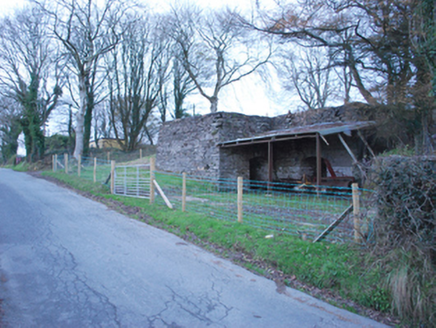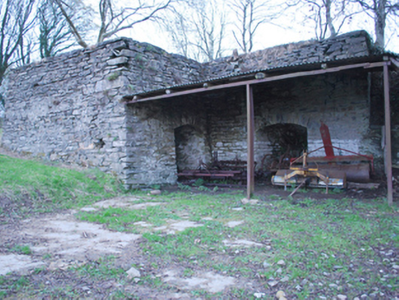Survey Data
Reg No
40905422
Rating
Regional
Categories of Special Interest
Social, Technical
Original Use
Kiln
In Use As
Outbuilding
Date
1800 - 1870
Coordinates
229359, 410031
Date Recorded
10/11/2010
Date Updated
--/--/--
Description
Freestanding two-bay lime kiln on L-shaped plan, erected c. 1820 and extended c. 1860. Now out of use or in use as outbuilding. Constructed of roughly coursed rubble stone masonry with roughly square-quoins to the corners. Segmental-headed openings to front (south) having roughly squared rubble stone voussoirs. Former loading chambers to top having rubble masonry construction; slightly raised rubble stone parapet to front. Built into sloping ground with former quarries to the north-west. Earthen embankment to rear, formerly giving access to loading chambers. Set slightly back from road in rural location to the east\south-east of Manorcunningham. Metal framed structure adjoining to the south-east having corrugated-metal canopy roof over. Cement forecourt to the front. Additional lime kilns to the north-west (see 40905432 and 40905433).
Appraisal
This interesting double lime kiln, probably originally erected during the early-to-mid nineteenth century, survives in good condition and retains its early character. Its form consisting of two adjoining lime kilns on L-shaped plan is unusual for its type, which adds rarity value to this site. It is well-built using local rubble stone masonry and is an appealing and unassuming element of the agricultural/industrial and social heritage of County Donegal. Cartographic information suggests that it was originally a single lime kiln with an additional kiln added c. 1860. The embankment to the rear was built/modified to allow for the easy loading of stone through openings in the roof structure, while the apertures to the front were used to fire the oven to burn the stone and produce lime. Lime kilns appear to have come into popular use in Ireland during the eighteenth century and were a very common feature in the rural landscape up until the first decades of the twentieth century. They were used to burn limestone to produce lime, which was used as an agricultural fertilizer and spread on agricultural land, or in construction as a mortar and a render. Lime was also used for lime-washing buildings, particularly farm buildings, as it was regarded as a cleansing agent at the time. This double kiln is more substantial than is more commonly encountered, which suggests a small-scale industrial process at the time as opposed to a kiln erected for use by a local farmer. Small rural lime kilns started to go out of common usage during the late nineteenth-century with the advent of industrial-scale lime production facilities and improvements in the transport network, particularly the development of the railways. This simple feature is an interesting feature in the rural landscape to the east of Manorcunningham, and is an integral element of the built heritage of the local area. It is one of a number of former lime kilns in close proximity at Lismoghry (see 40905432 and 40905433 for other sites) that were associated with a quarry adjacent to the north.



